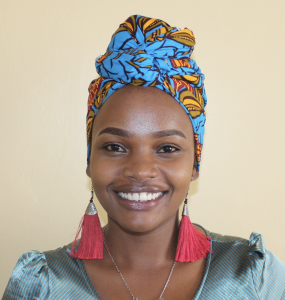People in Mukoko Community must traverse a steep hill to reach Mshimuli Spring. The road leading to the spring is very narrow and it is engulfed by tree branches and thick grass which is dangerous because it may cut the skin.
Mshimuli Spring is located in Kakamega County and borders Rosterman Village, which is known across Kenya as a major mining town. The spring is also close to a church called Pentecostal Assemblies of God.
The weather was very hot and still on the afternoon we visited the spring. Although once we arrived at the water spring, a pure and fresh breeze began. It became cooler as the day progressed and it later rained in the evening, so we had to wait for the rains to stop before returning back home.
Most of the 90 people living in this part of Mukoko are farmers. The green village draws birds and other animals to seek refuge here. There are decent primary schools nearby. And there is a well-established market center where the residents buy and sell goods. Some homes are permanent while others are made of mud walls and grass-thatched roofs.
A typical day starts when the sun rises in the morning. The women prepare the children for school as the sun gradually rises, spilling golden rays of light over the soaring valleys. The sounds of barking dogs and crowing roosters wake up the rest of the sleeping villagers. At about 6:30am, most of the morning house duties are done and the children are off to school.
The mother goes to the spring for water and then feeds the livestock while the father heads to the farm. At 5pm the children leave school and help their parents to close the day as the smell of home cooking fills the air and the sun slowly drops with a beautiful sunset view.
The 90 people who use Matolo Spring collect water with 10-liter plastic containers. The container is submerged into the spring while the individual is crouching and holding it until it is filled up.
The water is very dirty and smelly. It is open to contamination such as farm activities and soil erosion. The water is full of algae, dragonflies, reeds, rotten leaves and tadpoles. They bring the farm animals to drink from the spring which may indicate the presence of fecal matter hence the water is very unsafe for drinking.
Contaminated water spreads diseases not only through drinking but also through bathing, when the bacteria will get into the body. Without access to clean water, there is no way to clean food, dishes or the body, which brings about mental health issues including depression and anxiety. The community members use a lot of money visiting the hospitals instead of using it for other things.
"We use so much time to clean the water source because it has a lot of algae," said Emily Vihenda to us during a visit to the spring. "Protecting the spring will save us the time to work on other things that will improve our lives."
The community members are so happy because they thought they had been forgotten on matters concerning water, but are grateful that their spring will finally be protected.
In addition to clean water challenges, the members of the community need to be enlightened on better hygiene practices. They dispose of waste in the farms and use dirty water for cleaning which may cause the spread of deadly diseases. People put out buckets for rainwater during the rainy season and drink it without treatment - assuming it is safe and clean.
Fewer than half of all households have latrines. Most that exist are made of brick walls and grass roofs. The floors are often just mud, which leaves them prone to collapsing during the raining season. But there are some positive signs. For example, most of the community members have clotheslines which is a good hygiene practice.
What we can do:
Training
Community members will attend hygiene and sanitation training for at least two days. This training will ensure participants have the knowledge they need about healthy practices and their importance. The facilitator plans to use PHAST (Participatory Hygiene and Sanitation Transformation), CLTS (Community-Led Total Sanitation), ABCD (Asset-Based Community Development), group discussions, handouts, and demonstrations at the spring. One of the most important topics we plan to cover is the handling, storage, and treatment of water. Having a clean water source will be extremely helpful, but it is useless if water gets contaminated by the time it’s consumed. Handwashing will also be a big topic.
Training will also result in the formation of a committee that will oversee operations and maintenance at the spring. They will enforce proper behavior around the spring and delegate tasks that will help preserve the site, such as building a fence and digging proper drainage. The fence will keep out destructive animals, and the drainage will keep the area’s mosquito population at a minimum.
Sanitation Platforms
On the final day of training, participants will select five families that should benefit from new latrine floors.
Training will also inform the community and selected families on what they need to contribute to make this project a success. They must mobilize locally available materials, such as bricks, clean sand, hardcore, and ballast. The five families chosen for sanitation platforms must prepare by sinking a pit for the sanitation platforms to be placed over. All community members must work together to make sure that accommodations and food are always provided for the work teams.
Spring Protection
Protecting the spring will ensure that the water is safe, adequate and secure. Construction will keep surface runoff and other contaminants out of the water. With the community’s high involvement in the process, there should be a good sense of responsibility and ownership for the new clean water source.
Fetching water is predominantly a female role, done by both women and young girls. Protecting the spring and offering training and support will, therefore, help empower the female members of the community by giving them more time and efforts to engage and invest in income-generating activities.

 Protected Spring
Protected Spring
 Rehabilitation Project
Rehabilitation Project











































